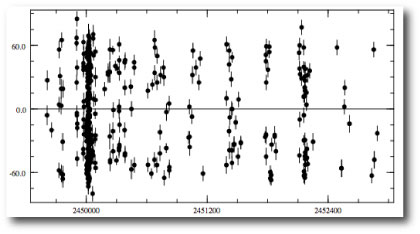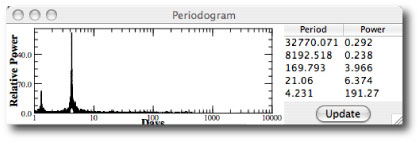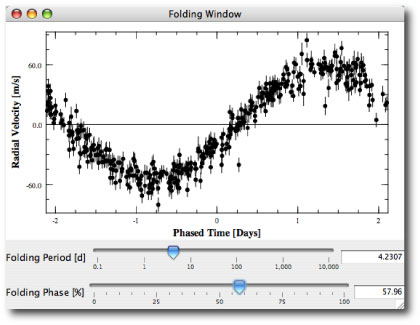
Saturday was an epic day for the radial velocity consuming public. Paul Butler and the California-Carnegie planet search team published a blockbuster paper in the Astrophysical Journal, and it looks like the first weekend’s gross is gonna be huge. The paper announces the detections of five new planets, and publishes re-analyzed and (in many cases) greatly expanded radial velocity data sets for no less than eighty three planet-bearing stars. The velocities are all available in machine-readable tabular form. No dextering, no unfolding, no typing, no postscript extractions. As an added plus, the paper also provides the latest estimates for jitter, mass, metallicity, and vsin(i) for all of the tabulated stars.
Needless to say, there’s a great deal of interesting data in this compendium. The updated 55 Cancri velocities, for example, should aid the characterization of a fully self-consistent model of that system. The slew of fresh velocities will be of great help in constraining the uncertainties in the transit predictions for planet bearing stars.
I dug right in to see how the 51 Peg system (described in a series of posts detailed here) is holding up. There are now 256 new and updated velocities from Lick Observatory to complement the 153 published Swiss velocities. The time-series shows a well-sampled mixture of long-term cadence and intensive monitoring.

Needless to say, 51 Peg b is still present with a vengeance. The power spectrum of the combined 409-point data set has a certain overwhelming 4.231 day character:

The data set phased at 4.2307 days shows a very nice sinusoid. About a thousand orbits have been folded down to make this plot:

So how does 51 Peg “c” fare in the new dataset? I’ll post an analysis tomorrow. If you’re impatient, though, you can use the downloadable console to investigate what the new data has to say.

Hi All,
All the data sets from the paper from the California-Carnegie planet search team are in the
console. The new data sets are indicated with B06 (sometimes followed by A, K, or L — for AAT, Keck,
or Lick, respectively).
Good hunting.
Eugenio
Pingback: Centauri Dreams » Blog Archive » An Updated Catalog of Nearby Exoplanets
Looks like the fits from this are available at http://exoplanets.org/planets.shtml
BTW what epoch does the console use for the mean anomaly value? Just wondering how to convert the time of periastron values into mean anomalies.
It seems the parameters given there for the 55 Cancri system have quite low eccentricities as well… did the paper give new radial velocities for 55 Cnc?
Hi Andy,
Thanks for the link. Exoplanets.org has done a very nice job of updating their site.
The mean anomaly on the console is the mean anomaly at the epoch of the earliest displayed data point. We adopted this choice so that the state of the console represents an initial condition, which is then evolved forward either with the kepler approximation or with integration in order to generate a fit.
best,
Greg
Hi Andy,
The parameters for 55Cnc are from Naef et al 2004
(A&A 414,315), and I could not find any radial velocities for 55Cnc in the Butler et al 2006 paper.
Eugenio
Eugenio’s right… Butler et al didn’t publish the fresh 55 Cnc velocities, which probably means they’ve got something interesting cooking.